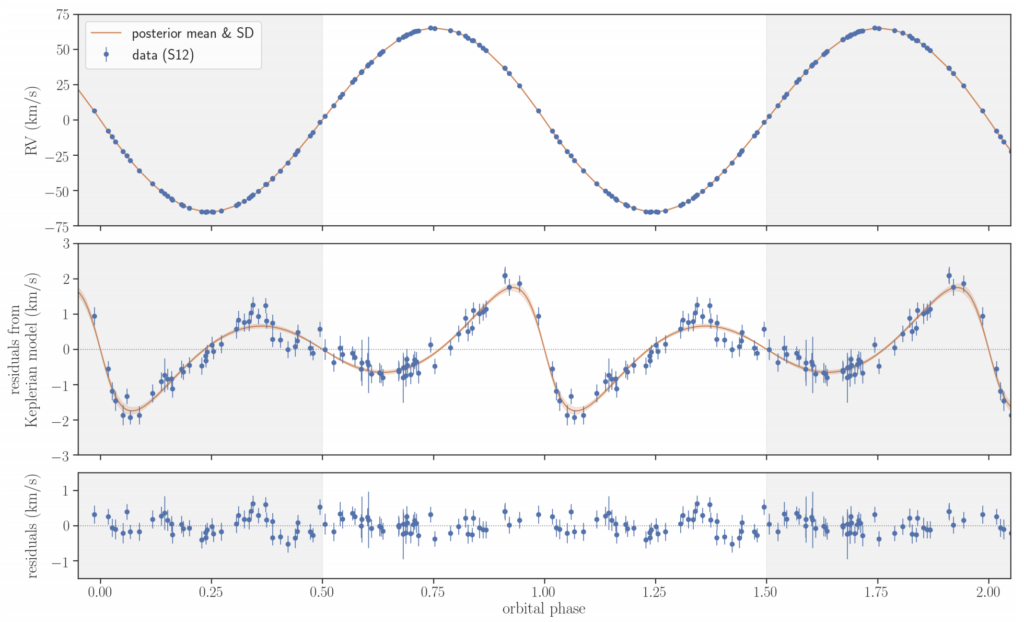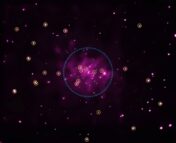Title: Tidal Effects on the Radial Velocities of V723 Mon: Additional Evidence for a Dark 3M⊙ Companion
Authors: Kento Masuda, Teruyuki Hirano
First Author’s Institution: Department of Earth and Space Science, Osaka University, Osaka 560-0043, Japan
Status: Accepted for publication in ApJ Letters
Hidden black holes
Stellar mass black holes represent one of the potential end stages of the death of a massive star. However, since isolated black holes give off no light, they are notoriously hard to find. In fact, most of the black holes we know of come either from searches for X-ray binaries, where mass accretes onto the black hole from a companion, or from gravitational wave detections. See this link for a visualization of the few stellar mass black holes known to date.
Fortunately, in recent years the number of non-interacting black holes (i.e. no mass accretion or mergers) detected through their gravitational interaction with a stellar companion has increased. One such system, a black hole candidate orbiting the red giant V723 Monoceros was recently discovered. This black hole candidate (with a mass of ~3 solar masses) is interesting because not only would it be the closest known black hole to date, but would also lie in the “mass gap,” a region above the masses of known neutron stars, but where relatively few black holes have been found. As such, these systems are of incredible interest to studying both stellar evolution and the nature of compact objects.
Tidal stretching
The authors of today’s paper use tidal effects of the putative black hole on its companion star to confirm the existence of a massive, dark object. Essentially, as the black hole and the star orbit their center of mass, the black hole tugs on the star causing a slight stretch. Figure 1 illustrates a cartoon version of how such an interaction looks. On the left we see a bird’s-eye view of the system and on the right is a simulated line profile. As different parts of the star’s deformed surface move towards and away from us (the observer), it causes shifts in the shape of observed absorption lines.

Absorption lines allow us to calculate the radial velocity of the star using the Doppler method. As the star moves towards and away from us, the lines shift blueward and redward in wavelength space. This tells us about the velocity of the star, which in turn allows us to calculate a companion mass. For more details on radial velocities see this astrobite. The authors of today’s paper model the effects of the black hole on the radial velocity signal, by cross-correlating the expected line profile at different phases in the orbit with a stellar template. In doing this, the authors are able to constrain the contribution of tidal effects to the total radial velocity signal. Figure 2 shows the results of this fit. The radial velocity is first modeled by a simple Keplerian orbit, but this shows significant residual signal. The tidal distortion model removes most of this.

Through their tidal model, the authors are able to constrain several important parameters of the system. Firstly, they are able to confirm the published red giant mass and the companion mass. They are also able to precisely measure the orbital properties of the system, which will be crucial for further follow-up. Finally, they measure several atmospheric properties of the red giant, which are important for detailed constraints on stellar modeling.
Binaries galore
With the continued search for exoplanets, radial velocity searches continue to probe smaller and smaller levels of velocity variations. Indeed, to find an Earth-like planet requires precision on the tens of cm/s level. While this is much smaller than the variations typically found in binary stars, the authors remind us that there is a growing wealth of radial velocity data on many stars in our Galaxy. Applying such a tidal model to binary stars, especially those where spots dilute the variability can allow us to obtain a deeper understanding of companion masses and the full range of binary systems. This is important for an understanding of the stellar populations in our Galaxy and stellar evolution in general.
Edited By: Macy Huston
Featured Image Credit: ESA/Hubble




